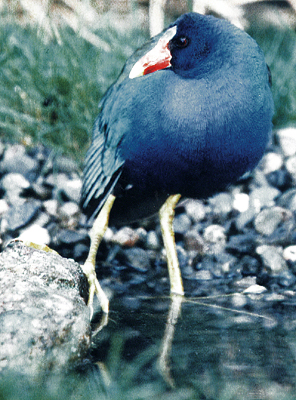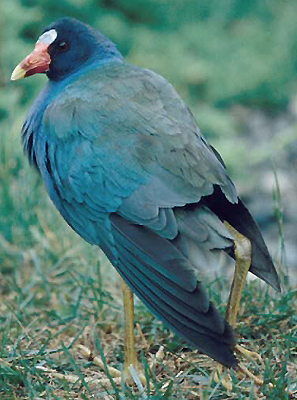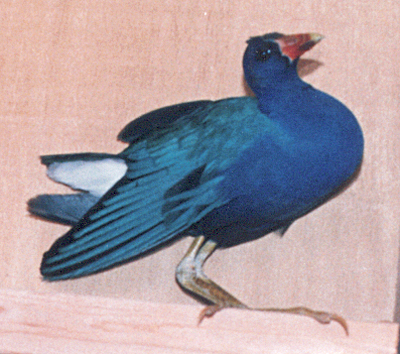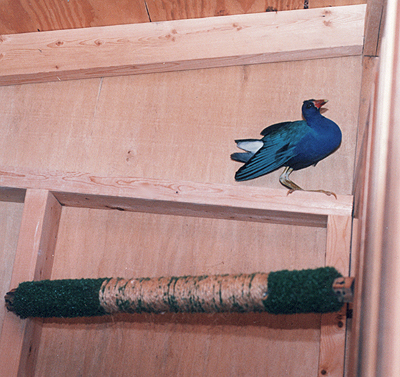|
Purple Gallinule
 There
are three photos on this page of an uncommon (and brightly colored!)
visitor to New England, a Purple Gallinule. A resident of southern
states such as Florida, the Purple Gallinule does not usually
travel north beyond Delaware, even in summer. Nevertheless, this
adult male was found in Massachusetts in 1998 and brought to
us with a broken right femur (thigh). There
are three photos on this page of an uncommon (and brightly colored!)
visitor to New England, a Purple Gallinule. A resident of southern
states such as Florida, the Purple Gallinule does not usually
travel north beyond Delaware, even in summer. Nevertheless, this
adult male was found in Massachusetts in 1998 and brought to
us with a broken right femur (thigh).
A shy, secretive marsh bird related to Rails and Coots, the Gallinule has long legs
used for wading and extended toes for walking on lily pads. These
birds depend on their legs as well as their wings, so without
our help, this adult male Purple Gallinule probably would have
perished.
The first photo here (above right) is a picture of the
injured bird, showing the broken right leg being held askew.
In this front view, he is still somewhat wary despite his weakened
condition. (Photo by Geoff Dennis.)
The second photo (below left) is a side view of the debilitated
Gallinule, before he was brought to us. The right leg is completely
useless. Note the long toes. (Photo by Geoff Dennis.)
Once the bird was brought to us, he was housed indoors
in a special cage in order to reduce the stress level on this
specimen of a highly timid and nervous species. Veterinarian
Chris Walker, DVM, donated his surgical services and skillfully
placed a metal rod (or "pin") in the bird's leg. This
allowed the bone to heal perfectly. The pin was later removed
during a second surgery.
Surprisingly, as we found out the hard way, Purple Gallinules
have a very special feature. These birds have a spur on the "wrist"
portion of each wing which may be used for both climbing and
defense. These spurs are sharp as cats' claws, and our patient
was not bashful about using these spurs to scratch us once he
was feeling better.
Below is a close-up of the healed and healthy Gallinule
in an outside enclosure, just before release. You can see here
how he was able to use both legs properly again. (Photo by Walter
S. Bezaniuk.)

And as we pull back to show you the whole photo, you can
see that our guest is fully alert. Note the wary posture! This
is a very satisfying contrast to the way the bird appears in
his first photos.

After five weeks in captivity, we released the Purple Gallinule.
His health restored and wildness intact, he took off like a rocket,
just a blue blur, and then disappeared into the marsh -- all
in all, a happy ending to this unusual tale.

 [Home]
[Whoooo are we?] [the
Story of Baby Birds] [Myths & Misconceptions]
[Home]
[Whoooo are we?] [the
Story of Baby Birds] [Myths & Misconceptions]
[FAQs] [How you can help] [Photo Gallery] [Contact]
[Donations]
[Shopping]
[Emergency? Click
here.]
This website and all its contents
belong to The Place for Wild Birds, Inc.
Copyright © 2002, all rights reserved. Reproduce only with
permission.
Photographs by Walter S. Bezaniuk, except where indicated. Most
illustrations by Kathleen Frisbie.
Site design and some illustrations by Sara. |